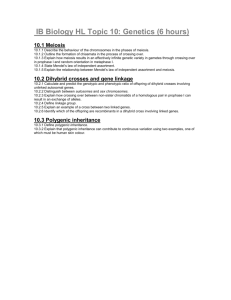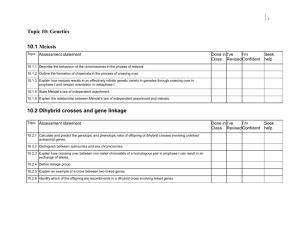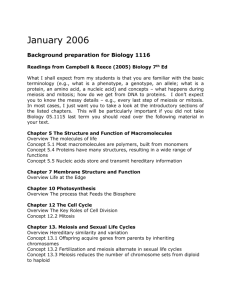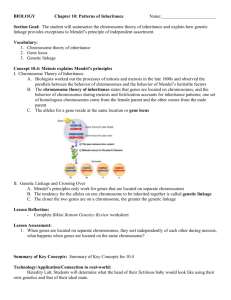Population Dynamics Humans, Sickle-cell Disease, and Malaria How does a population of humans
advertisement
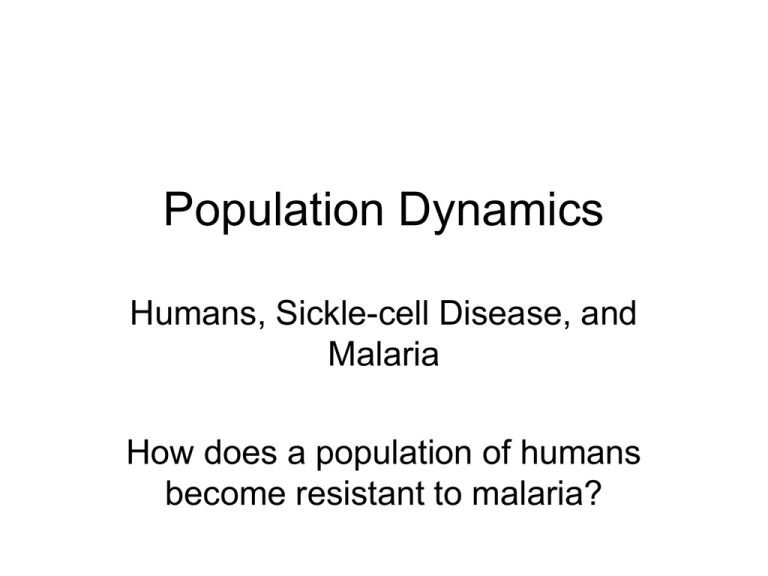
Population Dynamics Humans, Sickle-cell Disease, and Malaria How does a population of humans become resistant to malaria? Natural Selection • Overproduction • Environmental pressure/competition • Pre-existing individual variation • Heritable traits • Happens over generations (time) • Happens in populations (not single individuals) • Offspring must be viable and fertile The Origins of Genetic Variation – Offspring of sexual reproduction are genetically different from their parents and from one another. – Meiosis • Random mutations • Crossing over • Independent assortment of chromosomes – Random fertilization Meiosis and comparing it to Mitosis The Origins of Genetic Variation – Offspring of sexual reproduction are genetically different from their parents and from one another. – Meiosis • Random mutations • Crossing over • Independent assortment of chromosomes – Random fertilization Intergenerational Mutation Rate • By how many mutations does your genome differ from your parents genome? • Roach, et al., Science (2010) found about 60 mutations, 30 from each parent, that occurred during meiosis. Hemophilia in the Royal Family: Hypothesis - hemophilia allele arose through mutation in gamete of Queen Victoria’s mother or father. Crossing Over – In crossing over, • Homologous chromosomes exchange genetic information. • Genetic recombination occurs. Independent Assortment of Chromosomes – In independent assortment, every chromosome pair orients independently of the others during meiosis. Random Fertilization – The human egg cell is fertilized randomly by one sperm, leading to genetic variety in the zygote. Natural Selection • Overproduction • Environmental pressure/competition • Pre-existing individual variation • Heritable traits • Happens over generations (time) • Happens in populations (not single individuals) • Offspring must be viable and fertile Heritable Variation and Patterns of Inheritance - Ch 9 – Gregor Mendel • Was the first person to analyze patterns of inheritance. • Deduced the fundamental principles of genetics. Figure 9.6a Monohybrid Crosses – A monohybrid cross is a cross between parent plants that differ in only one characteristic. – Mendel’s law of segregation • The two members of an allele pair segregate (separate) from each other during the production of gametes. • Shown using a Punnett square. – Phenotype • An organism’s physical traits; what it looks like. – Genotype • An organism’s genetic makeup; what genes it has. Genetic Alleles and Homologous Chromosomes Figure 9.7 Independent Assortment of Chromosomes – In independent assortment, every chromosome pair orients independently of the others during meiosis. – Mendel developed four hypotheses from the monohybrid cross: • There are alternative forms of genes, called alleles. • For each characteristic, an organism inherits two alleles, one from each parent. • Alleles can be dominant or recessive. • Gametes carry only one allele for each inherited characteristic. Figure 9.5 Dihybrid cross Is the mating of parental varieties differing in two characteristics. – Mendel’s law of independent assortment states that • Each pair of alleles segregates independently of the other pairs during gamete formation. Figure 9.23 Using a Testcross to Determine an Unknown Genotype – A testcross is a mating between • An individual of unknown genotype and a homozygous recessive individual. Family Pedigrees •Shows the history of a trait in a family. •Allows geneticists to analyze human traits. Human Disorders Controlled by a Single Gene Variations On Mendel’s Laws – Some patterns of genetic inheritance are not explained by Mendel’s laws. • • • • Incomplete dominance Codominance Pleiotropy Polygenic Inheritance Incomplete Dominance in Plants and People – In incomplete dominance, F1 hybrids have an appearance in between the phenotypes of the two parents. Incomplete Dominance in Plants and People – In incomplete dominance, F1 hybrids have an appearance in between the phenotypes of the two parents. ABO Blood Type: An Example of Multiple Alleles and Codominance – The ABO blood groups in humans are an example of multiple alleles. – The immune system produces blood proteins • That may cause clotting when blood cells of a different type enter the body. Pleiotropy and Sickle-Cell Disease – Pleiotropy is the impact of a single gene on more than one characteristic. • Sickle-cell disease is an example. Figure 9.20 Polygenic Inheritance – Polygenic inheritance is the additive effects of two or more genes on a single phenotype. Figure 9.21 The Role of Environment – Many human characteristics result from a combination of heredity and environment. Figure 9.22 The Chromosomal Basis of Inheritance – The chromosome theory of inheritance states that • Genes are located at specific positions on chromosomes. • The behavior of chromosomes during meiosis and fertilization accounts for inheritance patterns. Figure 9.23 Linked Genes – Linked genes • Are located close together on a chromosome. • May be inherited together. The Process of Science: Are Some Genes Linked? – Using the fruit fly Drosophila melanogaster, Thomas Hunt Morgan determined • That some genes were linked based on the inheritance patterns of their traits. Figure 9.24 Genetic Recombination: Crossing Over – Two linked genes • Can give rise to four different gamete genotypes. • Can sometimes cross over. Crossing Over Figure 9.25 Figure 9.26 Linkage Maps – Early studies of crossing over were performed using the fruit fly Drosophila melanogaster. – Studies using Drosophila • Developed a method for mapping gene loci. • Resulted in linkage maps. Figure 9.27 Sex Chromosomes and SexLinked Genes – Sex chromosomes • Influence the inheritance of certain traits. Sex Determination in Humans and Fruit Flies – Sex chromosomes • Are designated X and Y. • Determine an individual’s sex. Figure 9.28 Sex-Linked Genes – Sex-linked genes • Are any genes located on a sex chromosome. • Were discovered during studies on fruit flies. Figure 9.29 – Inheritance patterns of a sex-linked gene Figure 9.30 Sex-Linked Disorders in Humans – A number of human conditions result from sex-linked (X-linked) genes. – Red-green color blindness • Is characterized by a malfunction of lightsensitive cells in the eyes. Figure 9.31 – Hemophilia • Is a blood-clotting disease. – Hemophilia • Is a blood-clotting disease. Figure 9.32 – Duchenne muscular dystrophy • Is characterized by a progressive weakening and loss of muscle tissue. The Rules of Probability – The rule of multiplication states that • The probability of a compound event is the product of the separate probabilities of the independent events. Figure 9.11

